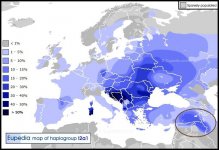bicicleur 2
Regular Member
- Messages
- 6,367
- Reaction score
- 1,402
- Points
- 113
The Cimmerians where mentioned by the Greek historian Herodotos.
According to wikipedia :
The Cimmerians or Kimmerians (Greek: Κιμμέριοι, Kimmerioi) were an ancient Indo-European people living north of the Caucasus and the Sea of Azov as early as 1300 BC[1] until they were driven southward by the Scythians into Anatolia during the 8th century BC. Linguistically they are usually regarded as Iranian, or possibly Thracian with an Iranian ruling class.
After their exodus from the Pontic steppe the Cimmerians probably assaulted Urartu about 714 BC, but in 705, after being repulsed by Sargon II of Assyria, they turned towards Anatolia and in 696–695 conquered Phrygia. In 652, after taking Sardis, the capital of Lydia, they reached the height of power. Their decline quickly began, and their final defeat is dated between 637 or 626, when they were defeated by Alyattes of Lydia. Thereafter, they are no longer mentioned in historical sources but probably settled in Cappadocia.[2]
On the I2a1 distribution map I noticed a spot with up to 20 % I2a1 in southeast Turkey and northern Iraq :

http://www.eupedia.com/images/content/Haplogroup_I2a.gif
On the R1a map there is a similar spot with upto 15 % R1a.
http://www.eupedia.com/images/content/Haplogroup-R1a.gif
What subclades of R1a and I2a1 are these?
Could this be the descendants of the Cimmerians?
According to wikipedia :
The Cimmerians or Kimmerians (Greek: Κιμμέριοι, Kimmerioi) were an ancient Indo-European people living north of the Caucasus and the Sea of Azov as early as 1300 BC[1] until they were driven southward by the Scythians into Anatolia during the 8th century BC. Linguistically they are usually regarded as Iranian, or possibly Thracian with an Iranian ruling class.
After their exodus from the Pontic steppe the Cimmerians probably assaulted Urartu about 714 BC, but in 705, after being repulsed by Sargon II of Assyria, they turned towards Anatolia and in 696–695 conquered Phrygia. In 652, after taking Sardis, the capital of Lydia, they reached the height of power. Their decline quickly began, and their final defeat is dated between 637 or 626, when they were defeated by Alyattes of Lydia. Thereafter, they are no longer mentioned in historical sources but probably settled in Cappadocia.[2]
On the I2a1 distribution map I noticed a spot with up to 20 % I2a1 in southeast Turkey and northern Iraq :

http://www.eupedia.com/images/content/Haplogroup_I2a.gif
On the R1a map there is a similar spot with upto 15 % R1a.
http://www.eupedia.com/images/content/Haplogroup-R1a.gif
What subclades of R1a and I2a1 are these?
Could this be the descendants of the Cimmerians?

